DIV IV - Links and Studs - Peasant Silver
Peasant silver links and toggles:
Links, as discussed here, are buttons with a mobile permanent attachment, of
one or more chain links. The shank remains in place, and if the link is
removed there is no difference between a regular button and a former link
button. Link buttons are two buttons joined together by a link. Toggle
buttons are buttons with a link attached to the shank at one end, and to a
bar at the other end.
While historians differ, it appears that collar links and collar studs were introduced by the late 17th century. It also appears that toggle buttons must have been worn in Spain at least by the 18th century to have influenced designs in Spanish southern Italy. There is one tantalizing example, undated, in a Mexican museum, that implies a 16th century date.
Toggle buttons were mainly worn in peasant costume around the Mediterranean. Buttons and toggles were worn interchangeably to fasten waistcoats, jackets and coats, and as decoration along the seams of the outer garments.. They were made by the same silversmiths, and have exactly the same appearance. Links (two buttons joined together by one or more links) and studs were mainly worn at the neck of the shirt. The use of links at the collar is very old, and predates the use of buttons to fasten clothes in Scandinavia. Collar links were used throughout Europe with peasant costume up to the late 19th century, by men and women; cuff links were not worn before the 19th century. In modern clothing, links and studs are now mainly worn on the shirt cuff, mostly by men, and the design of the decorative button front is usually quite different from the buttons worn elsewhere on the costume.
Peasant silver studs: Peasant studs mainly come from Scandinavia, particularly Sweden, where they were worn at the opening of the plain linen shift worn under other garments by both men and women. The neck opening was a short straight vertical cut at the top of the shift. It had a buttonhole at either side at the top, and the stud was pushed through both buttonholes at once to keep it cozily closed. The neckline remained visible when the outer garments were added, so the collar stud was usually large and decorative. The ones with long elaborate pendants were more commonly worn by women than men, and are usually Norwegian. Collar studs date from at least the 18th century, and their use pre-dates the use of buttons as fasteners down the front of the costume. Cuff-studs are smaller, and weren't introduced until the late 19th century. Collar studs were completely interchangeable with collar links, and the front is often identical to buttons from the same place and period. The stud fitting was usually a short stalk soldered to the back of the button with a flat plate at the end.
While historians differ, it appears that collar links and collar studs were introduced by the late 17th century. It also appears that toggle buttons must have been worn in Spain at least by the 18th century to have influenced designs in Spanish southern Italy. There is one tantalizing example, undated, in a Mexican museum, that implies a 16th century date.
Toggle buttons were mainly worn in peasant costume around the Mediterranean. Buttons and toggles were worn interchangeably to fasten waistcoats, jackets and coats, and as decoration along the seams of the outer garments.. They were made by the same silversmiths, and have exactly the same appearance. Links (two buttons joined together by one or more links) and studs were mainly worn at the neck of the shirt. The use of links at the collar is very old, and predates the use of buttons to fasten clothes in Scandinavia. Collar links were used throughout Europe with peasant costume up to the late 19th century, by men and women; cuff links were not worn before the 19th century. In modern clothing, links and studs are now mainly worn on the shirt cuff, mostly by men, and the design of the decorative button front is usually quite different from the buttons worn elsewhere on the costume.
Peasant silver studs: Peasant studs mainly come from Scandinavia, particularly Sweden, where they were worn at the opening of the plain linen shift worn under other garments by both men and women. The neck opening was a short straight vertical cut at the top of the shift. It had a buttonhole at either side at the top, and the stud was pushed through both buttonholes at once to keep it cozily closed. The neckline remained visible when the outer garments were added, so the collar stud was usually large and decorative. The ones with long elaborate pendants were more commonly worn by women than men, and are usually Norwegian. Collar studs date from at least the 18th century, and their use pre-dates the use of buttons as fasteners down the front of the costume. Cuff-studs are smaller, and weren't introduced until the late 19th century. Collar studs were completely interchangeable with collar links, and the front is often identical to buttons from the same place and period. The stud fitting was usually a short stalk soldered to the back of the button with a flat plate at the end.
Hover your mouse over the images below to see the back of the
links or studs
|
||
Peasant Silver Links |
||
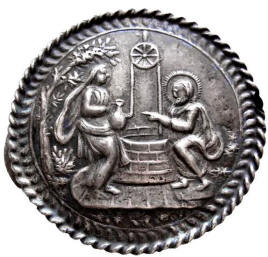 |
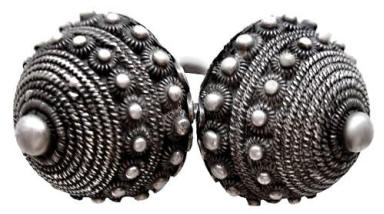 |
The link on the left is a Dutch silver klepstuk. 'Klepstukken were worn in pairs, by men, to close the flap of their breeches. The front shows Christ at the well with the woman of Samaria. The back is a plain silver button. It was made by C. Vreedenburgh Jr of Schoonhoven, 1920-1927. The plain circular link is typical of Dutch klepstukken. |
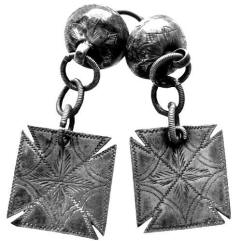 |
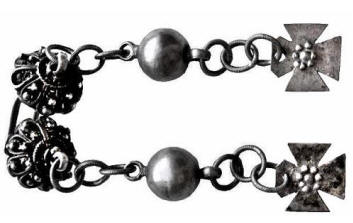 |
The link on the left is a Norwegian silver collar link, with typical long pendants. It was made by Søren Hammer in Bergen in 1842. Collar links like this are typical of western Norway. |
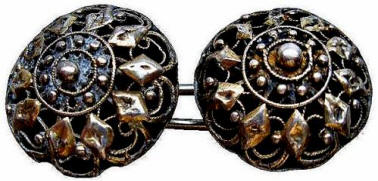 |
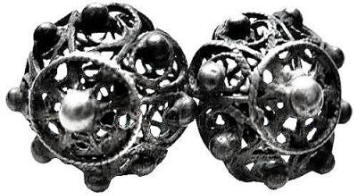 |
The link on the left is a Spanish silver filigree collar link, partly gilded. Spanish collar links usually have oval links, like this. |
Peasant Silver Toggles |
||
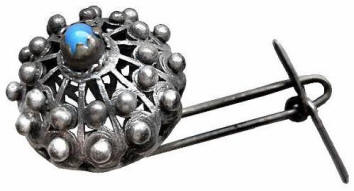 |
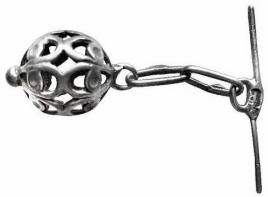 Back view same as front view |
The toggle on the left is a Sardinian silver filigree toggle button, set with a blue paste. The very long oval link, and the crossover wire bar, are typical. |
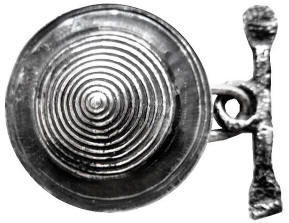 |
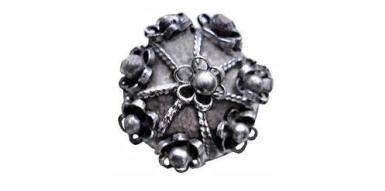 |
The toggle on the left is an Italian silver toggle button. The crudely cast bar, with splayed ends, is typical of southern Italy. It has marks on the ends of the bar showing it was made in Naples in the late 18th century. |
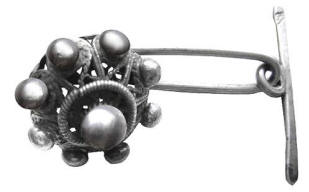 |
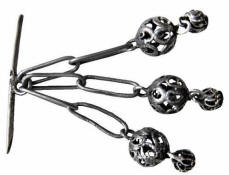 Back view same as front view |
The toggle on the left is a heavy Spanish silver filigree toggle button, for a woman. It has a plain bar with a soldered ring and is marked on one end with the maker's initials. |
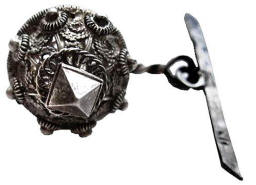 |
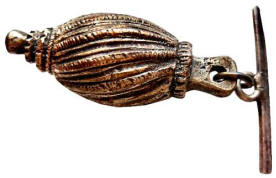 Back view same as front view |
The toggle on the left is a Dalmatian silver toggle button. The twisted wire link is typical of the Balkans. Bars can be various - this one is flat wire with diagonal ends, with the ring soldered. It has maker's marks on one end. |
Peasant Silver Studs - Norway and Sweden |
||
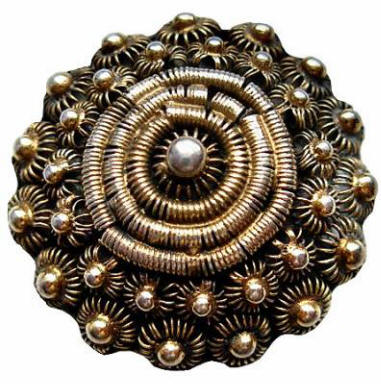 |
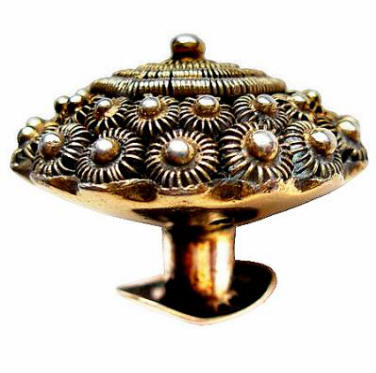 |
This is a large silver-gilt stud covered with coil-rings. It is Swedish, from around 1850, and has a Stockholm mark. |
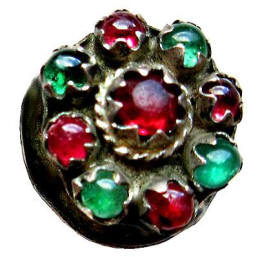 |
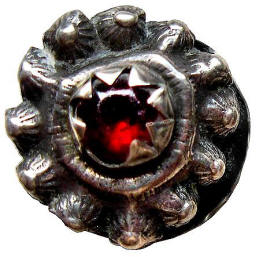 |
These two studs are also Swedish, and typical of those worn in Skåne. They are silver set with colored pastes. The one on the left, with the multiple pastes, has the marks of Gabriel Dahlberg of Lund, who worked from 1848-1893. The one on the right is a later version of the same design, and has the date letter S8 for 1944. |
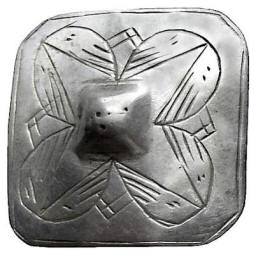 |
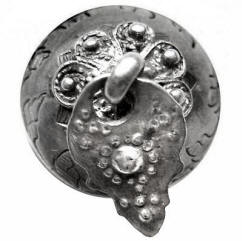 |
The stud on the left is also Swedish, also silver from Skåne, and very similar to contemporary buttons. It carries the marks of Anton Jacob Jörgensson, who worked in Ystad from 1818-1854. |
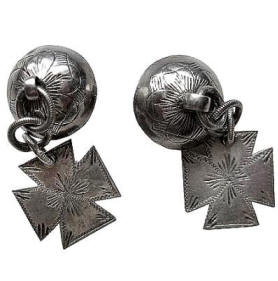 |
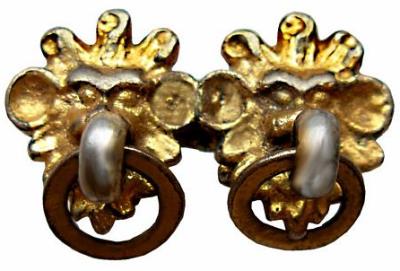 |
The two studs on the left are from Norway. The basic button part is identical with buttons and collar links worn throughout northern Europe in the 19th century. These each have full Bergen marks on the back. One was made by Cornelius Lausen in 1854, and the other by Hans Joachim Hagelien in 1832. The crescent cut in the back cuts through these marks, which might indicate that it was added later. |
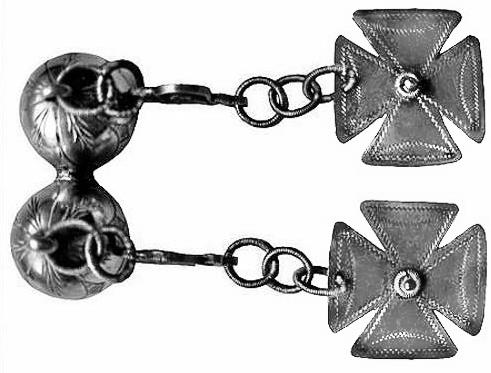 |
This is another Norwegian stud, probably from the first half of the 20th century. |
|
Peasant Silver Studs - Turkmenistan |
||
The next three studs are Gulyaka ("neck rose" or "flower") from Turkmenistan. They mainly date from the 1920s, and were worn by women, on the front of their costume, to fasten the blouse. They are absolutely enormous - the largest (on the left) is 5 1/2 inches across. Because of this they usually have the stud fitting near the edge of the back rather than the center, and some have two studs on the back. These are all made of silver, set with colored pastes or carnelians, and often have gilded highlights. |
||
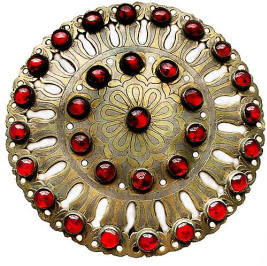 Tekke Turkoman stud, partly gilded silver with red pastes. |
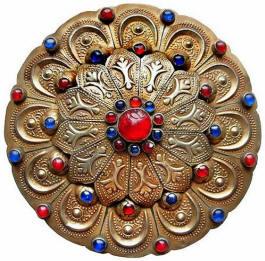 Yomut Turkoman stud, partly gilded and set with red and blue pastes. |
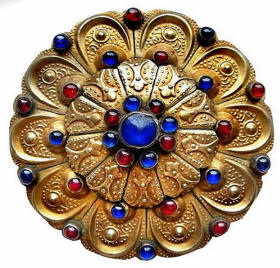 This stud is similar to the one at the left (with a brooch pin added). |
Peasant Silver Studs - Indian |
||
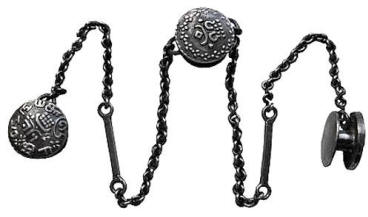 |
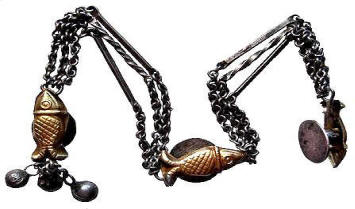 |
Studs like these were worn (and probably still are) by Muslim men throughout northern India and Pakistan in the late 19th and 20th centuries. They are usually made of silver in sets of three (although sets of five and seven exist), and were worn down the front of the shirt. The studs are linked by chains, and often have pendants attached. They can be round, but are also often in realistic (and auspicious) shapes, such as fish or hearts. |
Souvenir or Tourist Studs |
||
The following studs are not peasant silver, as they were never part of peasant costume. However, they were made using techniques, designs or styles which were used with other peasant jewelry. They were usually made by the kind of silversmiths who were skilled in making peasant jewelry, but also made souvenirs for tourists, who wanted something distinctive and characteristic from the area. They mostly date from the heyday of Victorian tourism in the mid-19th century. |
||
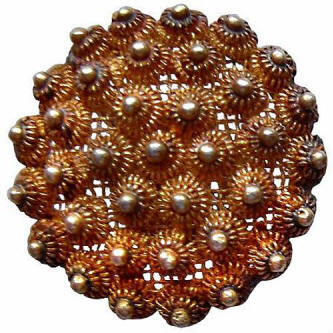 A silver-gilt filigree stud from the area around Genoa in northern Italy. Genoa was famous for its filigree in the 19th century, and this stud is typical of Genoese filigree, particularly the framework of netting. It is marked on the back with the Genoese lion mark used from 1832-1872. It was made to wear with women's costume. |
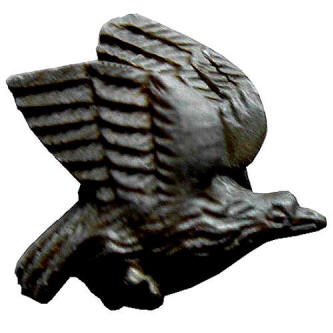 A realistic bird, carved entirely from pale grey 'lava'. This is in fact a kind of fine grained limestone found in several colors in the area around Pompeii, and used for souvenir jewelry sold in Naples. It was always called lava, and was used for all kinds of jewelry in the 19th century, particularly cameos. |
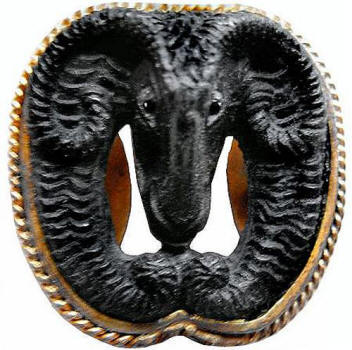 This stud is also made of lava - this time black lava set in silver-gilt. It is a realistic ram's head in the archaeological style popularized by the Castellani family in the mid 19th century. |
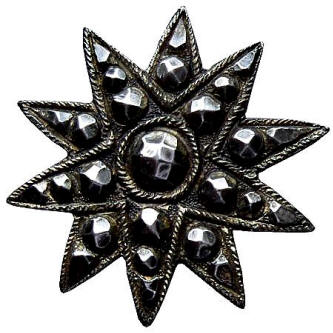 This stud is Indian, shaped like a star made of silver-gilt facetted to imitate cut-steel. It was probably made in Lucknow, which was famous for this kind of work. True buttons may exist, but the technique is more commonly used for hair pins, pendants, crosses, necklaces and the like. |
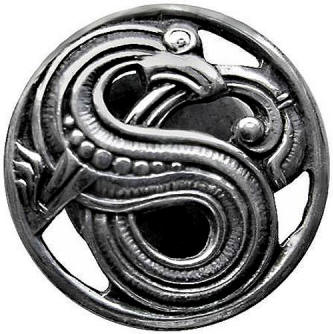 This stud is Norwegian, made around 1900 in the dragon style. It has the early back mark of David Andersen. |
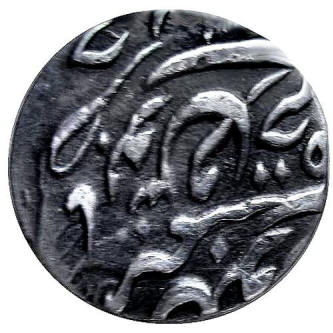 This stud was made from old heavy Hyderabad silver coins. These coins were made into all kinds of jewelry for the English in India, particularly buttons and studs, when they went out of use as coins in the 1870s. |
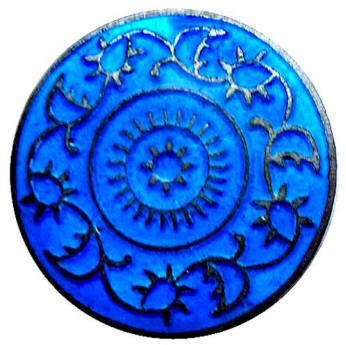 This stud is also Indian, from Multan (now in Pakistan.) Multan was famous for its enamel work in the 19th century. It is stamped VASNARAM MULTAN on the back. |
||
|
Acknowledgements: |
||